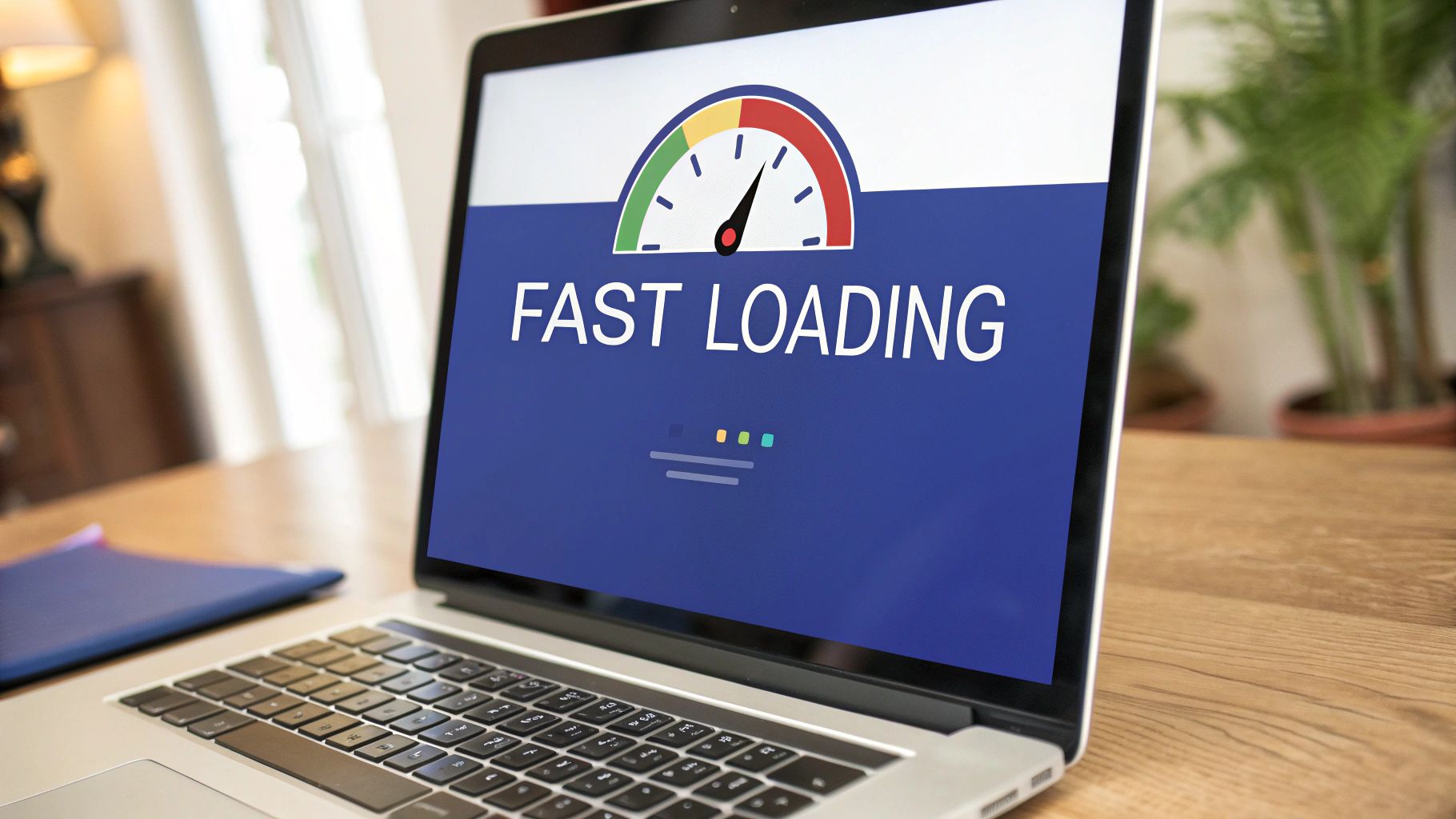The Business Impact of Website Performance

The speed and performance of your website directly impact your business success. When visitors have to wait for slow-loading pages, they get frustrated and leave – taking their potential purchases with them. This affects everything from your sales numbers to how people perceive your brand.
The Cost of Slow Websites
Poor website performance comes with a hefty price tag. E-commerce companies lose an estimated $2.6 billion every year because their websites take too long to load. Studies show that nearly 50% of users won't buy from a site that's too slow. The good news? Small improvements make a big difference. For online stores with 50,000 daily visitors, speeding up page loads by just one second can bring in $1.8 million more revenue annually. Check out more eye-opening data here: Learn more about website load time statistics.
User Engagement and Brand Perception
Speed shapes how users interact with your site. Fast, smooth-running pages keep visitors browsing longer and more likely to take action, whether that's making a purchase or signing up for your newsletter. When pages load slowly, users get impatient and leave quickly. Many won't return, and they might tell others about their poor experience. The result? Your brand's reputation takes a hit.
Building a Business Case for Optimization
Making your website faster isn't just a technical upgrade – it's a smart business move that pays off. Quick-loading pages lead to more sales, happier users, and a stronger brand image. When asking for resources to improve site speed, focus on the real business benefits: higher revenue, more engaged users, and increased customer satisfaction. These concrete results make a clear case for investing in performance improvements.
How Speed Optimization Drives Better Conversion Rates

The link between website speed and sales success is clear and compelling. Research analyzing over 100 million page views across different industries found that fast-loading sites achieve remarkably better results. Pages loading in just one second see 2.5-3x higher conversion rates compared to those taking five seconds to load. Put another way, quick-loading sites average 30.5 sales per 1,000 visitors, while slower sites manage only 10.8 – a dramatic difference that highlights why speed matters. See the full research data.
How Page Speed Influences Buying Decisions
Speed shapes how users perceive and interact with your site on a fundamental level. When pages load quickly, visitors feel confident in your professionalism and are more likely to complete purchases. But slow loading times erode trust rapidly, pushing potential customers to abandon their carts and look elsewhere. The psychology is simple – fast sites feel reliable, while slow ones raise red flags.
Finding and Fixing Speed Issues
Getting faster starts with spotting what's slowing you down. Tools like Google PageSpeed Insights and GTmetrix can pinpoint exact problems, from bulky images to script bloat. These insights let you focus optimization efforts where they'll have the biggest impact.
Advanced Speed Optimization Methods
Taking speed optimization further opens up major competitive advantages. A Content Delivery Network (CDN) can serve content from servers closer to users, while minimizing code through techniques like minification removes unnecessary bloat slowing down your pages.
Measuring the Impact on Results
Track how speed improvements affect your bottom line through consistent testing. Regular performance checks and A/B tests reveal which optimizations drive the most conversions. Want to learn more? Check out our guide on maximizing conversions through landing page optimization. Making speed a priority doesn't just boost sales – it creates better experiences that keep customers coming back.
Advanced Technical Optimization Strategies

Technical optimization is essential for taking your website performance to the next level. While basic best practices lay the foundation, implementing advanced strategies can give you a meaningful edge in both user experience and search rankings.
Next-Gen Image Optimization
Getting images right goes far beyond basic compression. WebP, Google's modern image format, can reduce file sizes by up to 30% compared to JPEG while maintaining visual quality. By implementing responsive images, your site automatically serves the perfect size for each device – no more forcing mobile users to download desktop-sized images. For instance, a 2000px wide hero image could be served as a 600px version on phones, dramatically improving load times.
Strategic Code Minification and Splitting
Think of code optimization like decluttering your home – removing unnecessary items makes everything run more smoothly. Code minification strips out extra spaces, comments and characters that browsers don't need, making files significantly smaller. Code splitting takes this further by breaking JavaScript into smaller chunks that load only when needed. For example, your homepage might load just the essential code first, while features like image galleries load their code later when visitors actually use them.
Intelligent Browser Caching
Smart caching strategies can make repeat visits lightning fast. When configured properly, browser caching stores static files locally on visitors' devices. This means images, stylesheets, and scripts only need to be downloaded once – on subsequent visits, they load instantly from the local cache. For instance, your logo, fonts, and core CSS could be cached for a month, while more dynamic content updates more frequently.
Balancing Performance With Functionality
Adding features and optimizing speed requires careful balance. Before implementing any new functionality, assess its performance impact using tools like Google PageSpeed Insights and GTmetrix. Set clear performance budgets and regularly audit your site to catch issues early. Focus on features that provide genuine user value without excessive performance costs. Remember – a blazing fast site with limited features often beats a slow site packed with bells and whistles.
Mastering Content Delivery and Caching Architecture

Want your website to load lightning-fast for users worldwide? Smart content delivery and caching are key. When implemented properly, these techniques ensure visitors experience quick page loads no matter where they're located.
Understanding CDN and Intelligent Routing
A Content Delivery Network (CDN) spreads your website's content across servers worldwide. This means users download files from servers close to their location instead of from a single distant server. For example, when someone in Tokyo visits your US-based site, they'll access content from a nearby Asian server rather than crossing the Pacific. This smart routing leads to:
- Faster load times across different regions
- Better site reliability during traffic spikes
- Reduced strain on your main server
Implementing Multi-layer Caching Strategies
Think of caching like keeping spare copies of your website's files in strategic locations. Multi-layer caching works on several levels:
- Browser Caching: Stores files like images and stylesheets on visitors' devices so repeat visits load instantly
- Edge Caching: Places copies of pages on CDN servers around the globe
- Application Caching: Keeps frequently-accessed data ready for quick retrieval
Managing Dynamic Content Effectively
What about content that changes often, like personalized recommendations or shopping carts? The solution is cache busting – selectively refreshing only the parts that have changed. This keeps dynamic elements current while maintaining speed.
Real-World Examples of Delivery Optimization
These aren't just theoretical benefits. Major e-commerce sites have seen dramatic improvements using CDNs and caching. One retailer achieved a 40% speed boost after implementing regional CDN servers and multi-layer caching, directly improving their sales and customer satisfaction.
Choosing the Right CDN and Configuration
Picking the right CDN service requires careful consideration of your needs. Focus on providers offering strong coverage in regions where your audience lives. Key factors include global server presence, security features, and cost-effectiveness. The right setup ensures visitors get the fastest possible experience.
By putting these content delivery and caching strategies to work, you can build a faster, more reliable site that keeps visitors coming back. The key is finding the right balance between fresh content and speed – when done well, your users won't even notice the complex systems working behind the scenes.
Mobile-First Performance Excellence
A well-optimized mobile website is now essential for reaching most users. With smartphones being the primary way people access the web, having a responsive design alone isn't enough anymore. You need a complete mobile-first performance strategy focused on delivering an exceptional experience to mobile visitors.
Optimizing Touch Interactions
Phone and tablet users navigate through taps and swipes rather than clicks and scrolls. This means optimizing touch interactions is crucial for usability. All interactive elements should have touch targets that are at least 48 pixels in size to prevent mis-taps. Text should be readable without zooming, and spacing between elements should accommodate finger-based navigation. These small details have a big impact on how easy your site is to use.
Effective Lazy Loading on Mobile
Lazy loading helps mobile pages load quickly by only downloading images and videos when needed. This is especially important for content-heavy pages with lots of media. Rather than forcing mobile users to download everything at once and wait, lazy loading delivers a fast initial page load by deferring non-essential content. Images load seamlessly as users scroll, creating a smooth browsing experience.
Using Modern Mobile Web Features
Today's mobile browsers include powerful capabilities for better performance. The Service Worker API enables offline access and faster loading through smart caching. Think of it like having a mini version of your site saved on users' phones – they can still access key content even with a poor connection. This is particularly valuable for repeat visitors and users in areas with unreliable internet.
AMP Implementation
Accelerated Mobile Pages (AMP) provides a framework from Google for creating extremely fast mobile pages. While implementing AMP requires following specific coding rules and may need some site restructuring, the speed improvements can be substantial. AMP pages load almost instantly, which helps keep mobile visitors engaged.
Network-Aware Loading Strategies
Mobile users access sites on widely varying connection speeds, from fast 5G to sluggish 2G networks. Network-aware loading adapts content delivery based on connection quality. On slower connections, you can serve compressed images and simplified animations while still maintaining core functionality. This helps ensure a good experience across different network conditions.
Mobile Performance Monitoring
Optimizing mobile performance requires ongoing measurement and refinement. Regular testing with tools like Google PageSpeed Insights helps identify issues and opportunities for improvement. Track key metrics over time, gather real user data, and continue enhancing the mobile experience. Performance optimization is an iterative process that pays off through better engagement and conversions.
Building a Culture of Continuous Performance Improvement
Website performance needs constant attention and effort to maintain – it's not something you can set and forget. Creating an organizational mindset focused on speed and efficiency requires clear processes, dedicated tools, and buy-in from your entire team.
Establishing Performance Budgets
Just like financial planning, performance budgets help control key metrics that impact your site's speed. Set specific targets like 3-second maximum load times or 100KB image size limits. Having these concrete goals prevents your site from getting slower as you add new features and content over time.
Implementing Effective Monitoring Systems
You need consistent monitoring to catch speed issues early. Tools like Google PageSpeed Insights, Pingdom, and GTmetrix provide vital performance data. Set up alerts to notify you when metrics drop below targets. Real user monitoring (RUM) shows how actual visitors experience your site – often revealing problems that test environments miss. For more tips on gathering user feedback, check out: How to master gathering feedback.
Fostering a Performance-First Mindset
Getting everyone focused on speed takes education and encouragement. Help your team understand how site performance directly impacts business goals. Create opportunities for developers, designers and content creators to collaborate on optimization. Recognize and reward team members who help make the site faster.
Managing Technical Debt
Like a cluttered house, technical debt builds up over time and slows everything down. Make addressing performance-related technical debt a regular part of development. This includes cleaning up inefficient code, optimizing images, and consolidating scripts. Regular code reviews and automated testing help catch issues before they become major problems.
Maintaining Optimization Momentum
Think of performance optimization as an ongoing journey, not a one-time fix. Schedule regular check-ins – weekly performance reviews, monthly deep dives, or quarterly optimization sprints. This consistent attention helps prevent backsliding and keeps your site running smoothly.
A fast, efficient website requires dedication and structure. With clear performance targets, solid monitoring, and a team committed to optimization, you can deliver great user experiences that help grow your business.
Want to improve how your team collaborates on website feedback? Check out BugSmash today!